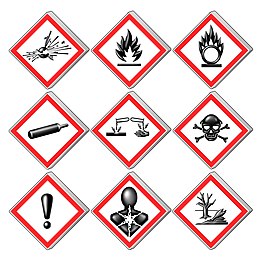Chemical hazard
Chemical hazards are classified into groups that include asphyxiants, corrosives, irritants, sensitizers, carcinogens, mutagens, teratogens, reactants, and flammables.
The use of personal protective equipment may substantially reduce the risk of adverse health effects from contact with hazardous materials.
[2] Long-term exposure to chemical hazards such as silica dust, engine exhausts, tobacco smoke, and lead (among others) have been shown to increase risk of heart disease, stroke, and high blood pressure.
[6] Chemicals may be ingested when food or drink is contaminated by unwashed hands or from clothing or poor handling practices.
The standard set of 9 hazard pictograms was published and distributed as a regulatory requirement through the efforts of the United Nations via the Globally Harmonized System of Classification and Labelling of Chemicals.
Therefore, the majority of these illnesses and deaths are thought to be caused by a lack of knowledge or awareness concerning the dangers of chemicals.
When engineering controls are implemented, there is a physical change made to the work environment that will eliminate or reduce the risk to chemical exposure.
This is the establishment of administrative and work practices that will reduce the amount of time and how often the workers will be exposed to the chemical hazard.
[19] Most carcinogens act by creating mutations in DNA that disrupt a cell's normal processes for regulating growth, leading to uncontrolled cellular proliferation.
This is typically a multi-step process during which the regulatory mechanisms within the cell are gradually dismantled allowing for unchecked cellular division.
[20] Activation-dependent agents are relatively inert in their original form, but are bioactivated in the body into metabolites or intermediaries capable of damaging human DNA.
These agents typically include electrophilic groups that react readily with the net negative charge of DNA molecules.
[23] Other organizations that evaluate the carcinogenicity of substances include the National Toxicology Program of the US Public Health Service, NIOSH, the American Conference of Governmental Industrial Hygienists and others.
[24] A 2017 SBU report found evidence that workplace exposure to silica dust, engine exhaust or welding fumes is associated with heart disease.
[3] An association was found between heart disease and exposure to compounds which are no longer permitted in certain work environments, such as phenoxy acids containing TCDD (dioxin) or asbestos.
There is evidence that workplace exposure to lead, carbon disulfide, or phenoxy acids containing TCDD, as well as working in an environment where aluminium is being electrolytically produced, are associated with stroke.
[28] Any contact with harmful chemicals during the first few months of pregnancy or even after has been connected to some miscarriages and has affected the menstrual cycle to the point that it has been able to block ovulation.

